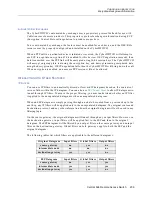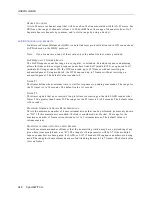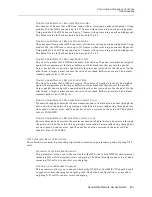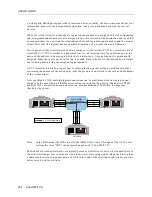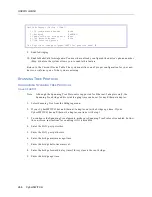
Central Site Remote Access Switch 253
C
ONFIGURING
A
LTERNATE
A
CCESSES
X.25 Accesses
N
ONSTANDARD
D
EFAULT
R
ECEIVE
W
INDOW
S
IZE
The number of frames that a DTE can receive without receiving an acknowledgment. Using
modulo 128, the DTEs can send up to 127 frames without receiving an acknowledgment. Using
modulo 8, the DTEs can send up to 7 frames without receiving an acknowledgment. The default
value for both modulo 8 and modulo 128 is 2.
N
ONSTANDARD
D
EFAULT
T
RANSMIT
P
ACKET
S
IZE
The size of a packet that a DTE can transmit. The choice of a packet size must be weighed against
the requirements for larger buffers at all the machines that process the packet. Larger packet sizes
reduce the opportunity for other devices to share the channel. On the other hand, a larger packet
reduces the ratio of overhead fields to user data. The default transmit packet size is 128 bytes.
N
ONSTANDARD
D
EFAULT
R
ECEIVE
P
ACKET
S
IZE
The size of a packet that a DTE can receive. The choice of a packet size must be weighed against the
requirements for larger buffers at all the machines that process the packet. Larger packet sizes
reduce the opportunity for other devices to share the channel. On the other hand, a larger packet
reduces the ratio of overhead fields to user data. The default transmit packet size is 128 bytes.
N
ONSTANDARD
D
EFAULT
T
RANSMIT
T
HROUGHPUT
C
LASS
Transmit throughput describes the maximum amount of data that can be sent through the network,
when the network is operating at saturation. Factors influencing throughput are line speeds,
window sizes, and the number of active sessions in the network. The default value is 19,200 BPS.
N
ONSTANDARD
D
EFAULT
R
ECEIVE
T
HROUGHPUT
C
LASS
Receive throughput describes the maximum amount of data that can be received through the
network, when the network is operating at saturation. Factors influencing throughput are line
speeds, window sizes, and the number of active sessions in the network. The default value is 19,200
BPS.
X.25 A
CCESS
B
ACKGROUND
I
NFORMATION
X.25 was developed to provide an interface that would allow computers or terminals that use
different data communications protocols to exchange data across wide area packet-switching
networks. Since its inception by CCITT in 1974, it has been expanded to include many options,
services, and facilities.
Packet-switching is a transmission method in which data is broken down into packets. The packets
are sent across a shared medium from source to destination. The transmission may use any
available circuit. The next packet in the transmission may take a different route. Multiple packets
from the same transmission can be sent at the same time. Because of the switching, the packets may
not all take the same route, and they may not arrive in the order that they were sent. When they
arrive at their destination, the packets are reassembled in the proper order, and a check is done to
see if all expected packets arrived.
X.25 provides common procedures between a device (DTE) and a packet network (DCE) for
establishing a connection to the network, exchanging data with another DTE, and releasing the
connection. X.25 contains no algorithms for routing the packets across the wide area network.
Consequently, an X.25 Network does not mean that the internal operations of the network use X.25.
It simply means that the interface to a packet data network is governed by the X.25 protocol.
Virtual circuits are used to establish a virtual path from one DTE to another. This virtual path
appears to have the same characteristics that you might get from a physical telephone circuit. With
Содержание Cabletron CyberSWITCH CSX5500
Страница 684: ...USER S GUIDE 684 CyberSWITCH NETWORK TOPOLOGY...

